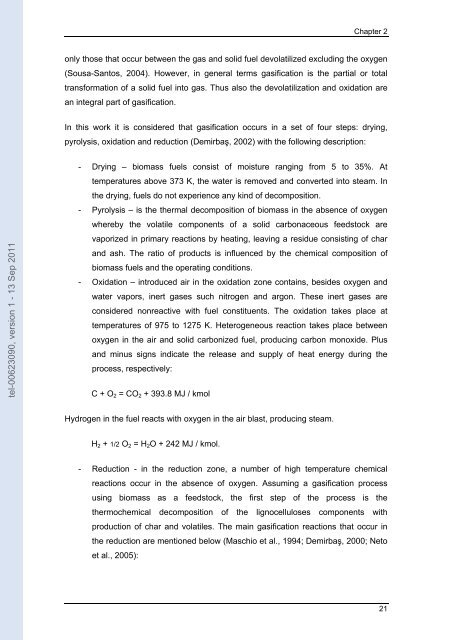Etude de la combustion de gaz de synthèse issus d'un processus de ...
Etude de la combustion de gaz de synthèse issus d'un processus de ...
Etude de la combustion de gaz de synthèse issus d'un processus de ...
You also want an ePaper? Increase the reach of your titles
YUMPU automatically turns print PDFs into web optimized ePapers that Google loves.
Chapter 2<br />
only those that occur between the gas and solid fuel <strong>de</strong>vo<strong>la</strong>tilized excluding the oxygen<br />
(Sousa-Santos, 2004). However, in general terms gasification is the partial or total<br />
transformation of a solid fuel into gas. Thus also the <strong>de</strong>vo<strong>la</strong>tilization and oxidation are<br />
an integral part of gasification.<br />
In this work it is consi<strong>de</strong>red that gasification occurs in a set of four steps: drying,<br />
pyrolysis, oxidation and reduction (Demirbaş, 2002) with the following <strong>de</strong>scription:<br />
tel-00623090, version 1 - 13 Sep 2011<br />
- Drying – biomass fuels consist of moisture ranging from 5 to 35%. At<br />
temperatures above 373 K, the water is removed and converted into steam. In<br />
the drying, fuels do not experience any kind of <strong>de</strong>composition.<br />
- Pyrolysis – is the thermal <strong>de</strong>composition of biomass in the absence of oxygen<br />
whereby the vo<strong>la</strong>tile components of a solid carbonaceous feedstock are<br />
vaporized in primary reactions by heating, leaving a residue consisting of char<br />
and ash. The ratio of products is influenced by the chemical composition of<br />
biomass fuels and the operating conditions.<br />
- Oxidation – introduced air in the oxidation zone contains, besi<strong>de</strong>s oxygen and<br />
water vapors, inert gases such nitrogen and argon. These inert gases are<br />
consi<strong>de</strong>red nonreactive with fuel constituents. The oxidation takes p<strong>la</strong>ce at<br />
temperatures of 975 to 1275 K. Heterogeneous reaction takes p<strong>la</strong>ce between<br />
oxygen in the air and solid carbonized fuel, producing carbon monoxi<strong>de</strong>. Plus<br />
and minus signs indicate the release and supply of heat energy during the<br />
process, respectively:<br />
C + O 2 = CO 2 + 393.8 MJ / kmol<br />
Hydrogen in the fuel reacts with oxygen in the air b<strong>la</strong>st, producing steam.<br />
H 2 + 1/2 O 2 = H 2 O + 242 MJ / kmol.<br />
- Reduction - in the reduction zone, a number of high temperature chemical<br />
reactions occur in the absence of oxygen. Assuming a gasification process<br />
using biomass as a feedstock, the first step of the process is the<br />
thermochemical <strong>de</strong>composition of the lignocelluloses components with<br />
production of char and vo<strong>la</strong>tiles. The main gasification reactions that occur in<br />
the reduction are mentioned below (Maschio et al., 1994; Demirbaş, 2000; Neto<br />
et al., 2005):<br />
21

















